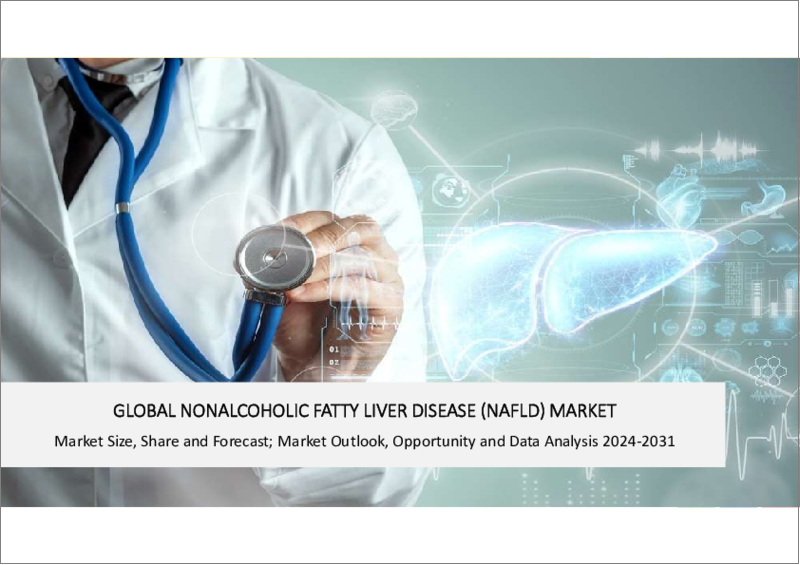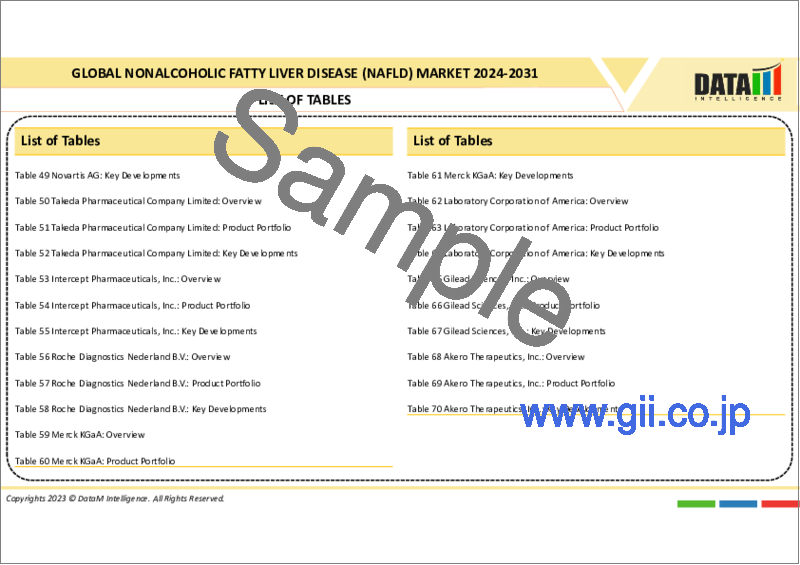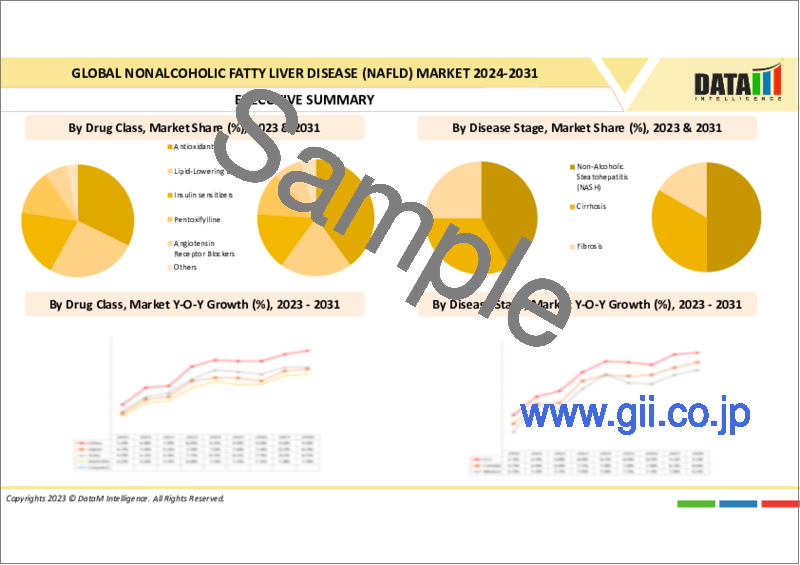|
|
市場調査レポート
商品コード
1374879
非アルコール性脂肪性肝疾患(NAFLD)の世界市場:2023~2030年Global Nonalcoholic Fatty Liver Disease (NAFLD) Market - 2023-2030 |
||||||
カスタマイズ可能
適宜更新あり
|
|||||||
| 非アルコール性脂肪性肝疾患(NAFLD)の世界市場:2023~2030年 |
|
出版日: 2023年11月01日
発行: DataM Intelligence
ページ情報: 英文 186 Pages
納期: 即日から翌営業日
|
- 全表示
- 概要
- 目次
非アルコール性脂肪性肝疾患(NAFLD)とは、肝臓に脂肪が蓄積することによって引き起こされる様々な症状を指す言葉です。通常、過体重や肥満の人に見られます。健康な肝臓には脂肪はほとんどないはずです。英国では、3人に1人近くが、肝臓に脂肪がほとんどない早期のNAFLDであると評価されています。早期のNAFLDは通常、害をもたらすことはないが、悪化すると肝硬変を含む重篤な肝障害につながる可能性があります。
現在、インスリン増感剤(チアゾリジン系薬剤)と抗酸化剤(ビタミンE)がNAFLD/NASHに非常に有利な治療薬であると考えられており、脂質低下薬、インスリン増感剤、アンジオテンシン受容体拮抗薬、n-3系多価不飽和脂肪酸も治療に採用されています。
市場力学:促進要因・抑制要因
高い有病率
非アルコール性脂肪性肝疾患(NAFLD)の有病率の高さは、予測期間中の世界市場の成長を後押しすると予想されます。例えば、米国国立糖尿病・消化器・腎臓病研究所(NIDDK)は、NAFLDは、肥満などの特定の疾患や障害、2型糖尿病を含む肥満に関連する可能性のある症状を持つ人に非常に典型的であるとしています。調査によると、2型糖尿病患者の3分の1から3分の2がNAFLDです。また、調査によると、NAFLDは過体重の人の約75%、重度の肥満の人の90%以上にみられるという。
さらに、米国肝臓財団によると、米国では約1億人が非アルコール性脂肪性肝疾患であると評価されています。非アルコール性脂肪性肝疾患(NAFLD)は、小児の肝障害の中で最も典型的な疾患であり、過去20年間で2倍に増加しています。
厳しい規制当局
新薬治療を認可する規制当局の厳しさは、世界市場の成長を妨げると予想されます。さらに、高い医薬品開発コストと治療副作用も、予測期間中の世界市場成長の妨げになると予想されます。
目次
第1章 調査手法と調査範囲
第2章 定義と概要
第3章 エグゼクティブサマリー
第4章 市場力学
- 影響要因
- 促進要因
- 高い有病率
- 抑制要因
- 厳しい規制当局
- 機会
- 影響分析
- 促進要因
第5章 産業分析
- ポーターのファイブフォース分析
- サプライチェーン分析
- 価格分析
- 規制分析
- 償還分析
- 特許分析
- パイプライン分析
- 疫学分析
- SWOT分析
- DMIオピニオン
第6章 COVID-19分析
第7章 薬剤クラス別
- 抗酸化薬
- 脂質低下薬
- インスリン感作薬
- ペントキシフィリン
- アンジオテンシン受容体遮断薬
- その他
第8章 病期別
- 非アルコール性脂肪性肝炎(NASH)
- 肝硬変
- 線維症
第9章 投与経路別
- 注射
- 経口
- その他
第10章 流通チャネル別
- 病院薬局
- 小売薬局
- オンライン薬局
- その他
第11章 地域別
- 北米
- 米国
- カナダ
- メキシコ
- 欧州
- ドイツ
- 英国
- フランス
- イタリア
- スペイン
- その他の欧州
- 南米
- ブラジル
- アルゼンチン
- その他の南米
- アジア太平洋
- 中国
- インド
- 日本
- オーストラリア
- その他のアジア太平洋
- 中東・アフリカ
第12章 競合情勢
- 競合シナリオ
- 市況/シェア分析
- M&A分析
第13章 企業プロファイル
- Pfizer Inc.
- 企業概要
- 製品ポートフォリオと説明
- 財務概要
- 主な発展
- AstraZeneca
- Novartis AG
- Takeda Pharmaceutical Company Limited.
- Intercept Pharmaceuticals, Inc.
- F. Hoffmann-La Roche AG
- Merck & Co., Inc.
- AbbVie Inc.
- Gilead Sciences, Inc.
- Akero Therapeutics, Inc.
第14章 付録
Overview
Non-alcoholic fatty liver disease (NAFLD) is the term for a spectrum of conditions caused by a build-up of fat in the liver. It's usually seen in people who are overweight or obese. A healthy liver should contain little or no fat. It is assessed that nearly 1 in out of 3 individuals in the UK has premature phases of NAFLD where there exist little quantities of fat in their liver. Early-stage NAFLD does not usually induce any harm, but it can direct to severe liver damage, including cirrhosis if it gets worse.
Presently, insulin sensitizers (thiazolidinediones) and antioxidants (vitamin E) appear to be the highly advantageous therapeutic agents for NAFLD/NASH, and lipid-lowering drugs, Insulin sensitizers, angiotensin receptor blockers, and n-3 polyunsaturated fatty acids also have been employed in the treatment.
Market Dynamics: Drivers & Restraints
High Prevalence of Condition
The high prevalence of Nonalcoholic Fatty Liver Disease (NAFLD) is expected to boost the global market growth during the forecast period. For instance, National Institute of Diabetes and Digestive and Kidney Diseases (NIDDK) NAFLD is highly typical in individuals who have certain diseases and disorders, such as obesity, and conditions that may be linked to obesity, including type 2 diabetes. Investigations indicate that one-third to two-thirds of individuals with type 2 diabetes have NAFLD. Research also indicates that NAFLD is present in around 75% of individuals who are overweight and in over 90% of individuals who have severe obesity.
Moreover, according to the American Liver Foundation, approximately 100 million people in the United States are assessed to have nonalcoholic fatty liver disease. Nonalcoholic Fatty Liver Disease (NAFLD), is the most typical condition of liver disorder in children and has increased two folds over the past 20 years.
Stringent Regulatory Authorities
The stringent regulatory authorities authorizing the new drug treatments are expected to hamper the global market growth. Furthermore, high drug development costs and treatment side effects are also expected to hamper the global market growth in the forecast period.
Segment Analysis
The global Nonalcoholic Fatty Liver Disease (NAFLD) market is segmented based on drug class, disease stage, route of administration, distribution channel and region.
Non-Alcoholic Steatohepatitis (NASH) Stage of NAFLD is Expected to Dominate Market
Owing to the increasing research approval from the FDA the Non-Alcoholic Steatohepatitis (NASH) Stage of NAFLD is expected to dominate the global market during the forecast period. For instance, in September 2023 Madrigal Pharmaceuticals, Inc., a clinical-stage biopharmaceutical corporation pursuing novel therapeutics for nonalcoholic steatohepatitis (NASH), obtained the U.S. Food and Drug Administration (FDA) New Drug Application (NDA) award for resmethrin to treat adult patients with NASH with liver fibrosis.
Moreover, in June 2023, Merck, obtained Fast Track Designation from the U.S. Food and Drug for Efinopegdutide, a technology transferred from the South Korean pharmaceutical corporation Hanmi Pharmaceutical Co., to treat nonalcoholic steatohepatitis (NASH). Similarly, in May 2022, Pfizer Inc. acquired the U.S. Food and Drug Administration (FDA) Fast Track designation for its investigational combination therapy for the treatment of non-alcoholic steatohepatitis (NASH) with liver fibrosis.
Geographical Analysis
North America is Expected to Dominate the Global Market
The increasing research funding and investments in North America are expected to boost the regional market growth, thereby dominating the global market in the forecast period. For instance, in September 2022, Rivus Pharmaceuticals Inc., a clinical-stage biopharmaceutical corporation committed to enhancing cardio-metabolic health, secured a $132 million Series B financing conducted by RA Capital Management with participation from Bain Capital Life Sciences, BB Biotech AG and existing investors Longitude Capital, Medicxi and RxCapital. This financing is expected to additionally sustain the clinical advance of principal nominee HU6, a first-in-class Controlled Metabolic Accelerator (CMA) developed for the treatment of cardio-metabolic disorder by managing obesity, a direct driver of disorder.
Moreover, since there are no medications authorized by the U.S. Food and Drug Administration (FDA) for the treatment of NAFLD. A recent $9.57 million funding granted to researchers with the UC San Diego NAFLD Research Center at the University of California San Diego School of Medicine is expected to aid in the clinical trial to investigate new threatment choices for individuals with the condition.
COVID-19 Impact Analysis
The pandemic is estimated to have positively impacted the global market growth owing to an increase in treatment demand as Plasminogen activator inhibitor-1 is observed to be advanced in COVID-19 patients. While the level of PAI-1 is significantly elevated in fibrotic tissues, the lack of PAI-1 protects different organs from fibrosis in response to injury-related profibrotic signals.
Thus, PAI-1 is implicated in the pathology of fibrosis in different organs including the heart, lung, kidney, liver, and skin. This role of PAI-1 in COVID-19 liver injury is potentially interesting, especially in NAFLD patients, as elevated PAI-1 has been associated with NAFLD and NASH therefore, COVID-19-induced PAI-1 elevation aggravated NAFLD.
Market Segmentation
By Drug Class
- Antioxidants
- Lipid-Lowering Drugs
- Insulin sensitizers
- Pentoxifylline
- Angiotensin receptor blockers
- Others
By Disease Stage
- Non-Alcoholic Steatohepatitis (NASH)
- Cirrhosis
- Fibrosis
By Route of Administration
- Injectable
- Oral
- Other
By Distribution Channel
- Hospital Pharmacies
- Retail Pharmacies
- Online Pharmacies
- Others
By Region
- North America
- U.S.
- Canada
- Mexico
- Europe
- Germany
- UK
- France
- Italy
- Spain
- Rest of Europe
- South America
- Brazil
- Argentina
- Rest of South America
- Asia-Pacific
- China
- India
- Japan
- Australia
- Rest of Asia-Pacific
- Middle East and Africa
Key Developments
- In April 2022, Oramed Pharmaceuticals Inc. acquired the patent termed "Methods and Compositions for Treating NAFLD, Hepatic Steatosis, and Sequelae Thereof" from the European Patent Office. They have produced oral protein delivery platform technology which protects therapeutic proteins in the digestive system.
- In March 2023 Akero Therapeutics, Inc., a clinical-stage corporation designing transformational therapies for patients with serious metabolic disorders and high unmet medical needs, declared positive End-of-Phase 2 meeting with the U.S. Food and Drug Administration (FDA) and details of the anticipated SYNCHRONY Phase 3 efruxifermin schedule for the treatment of nonalcoholic steatohepatitis (NASH).
Competitive Landscape
The major global players in the market include: Pfizer Inc., AstraZeneca, Novartis AG, Takeda Pharmaceutical Company Limited., Intercept Pharmaceuticals, Inc., F. Hoffmann-La Roche Ag, Merck & Co., Inc., Abbvie Inc., And Gilead Sciences, Inc. among others.
Why Purchase the Report?
- To visualize the global Nonalcoholic Fatty Liver Disease (NAFLD) market segmentation based on drug class, disease stage, route of administration, distribution channel and region as well as understand key commercial assets and players.
- Identify commercial opportunities by analyzing trends and co-development.
- Excel data sheet with numerous data points of Nonalcoholic Fatty Liver Disease (NAFLD) market-level with all segments.
- PDF report consists of a comprehensive analysis after exhaustive qualitative interviews and an in-depth study.
- Product mapping available as excel consisting of key products of all the major players.
The global Nonalcoholic Fatty Liver Disease (NAFLD) market report would provide approximately 64 tables, 61 figures and 186 pages.
Target Audience 2023
- Manufacturers/ Buyers
- Industry Investors/Investment Bankers
- Research Professionals
- Emerging Companies
Table of Contents
1. Methodology and Scope
- 1.1. Research Methodology
- 1.2. Research Objective and Scope of the Report
2. Definition and Overview
3. Executive Summary
- 3.1. Snippet by Drug Class
- 3.2. Snippet by Disease Stage
- 3.3. Snippet by Route of Administration
- 3.4. Snippet by Distribution Channel
- 3.5. Snippet by Region
4. Dynamics
- 4.1. Impacting Factors
- 4.1.1. Drivers
- 4.1.1.1. High Prevalence of Condition
- 4.1.2. Restraints
- 4.1.2.1. Stringent Regulatory Authorities
- 4.1.3. Opportunity
- 4.1.4. Impact Analysis
- 4.1.1. Drivers
5. Industry Analysis
- 5.1. Porter's Five Force Analysis
- 5.2. Supply Chain Analysis
- 5.3. Pricing Analysis
- 5.4. Regulatory Analysis
- 5.5. Reimbursement Analysis
- 5.6. Patent Analysis
- 5.7. Pipeline Analysis
- 5.8. Epidemiology
- 5.9. SWOT Analysis
- 5.10. DMI Opinion
6. COVID-19 Analysis
- 6.1. Analysis of COVID-19
- 6.1.1. Scenario Before COVID
- 6.1.2. Scenario During COVID
- 6.1.3. Scenario Post COVID
- 6.2. Pricing Dynamics Amid COVID-19
- 6.3. Demand-Supply Spectrum
- 6.4. Government Initiatives Related to the Market During Pandemic
- 6.5. Manufacturers Strategic Initiatives
- 6.6. Conclusion
7. By Drug Class
- 7.1. Introduction
- 7.1.1. Market Size Analysis and Y-o-Y Growth Analysis (%), By Drug Class
- 7.1.2. Market Attractiveness Index, By Drug Class
- 7.2. Antioxidants*
- 7.2.1. Introduction
- 7.2.2. Market Size Analysis and Y-o-Y Growth Analysis (%)
- 7.3. Lipid-Lowering Drugs
- 7.4. Insulin sensitizers
- 7.5. Pentoxifylline
- 7.6. Angiotensin Receptor Blockers
- 7.7. Others
8. By Disease Stage
- 8.1. Introduction
- 8.1.1. Market Size Analysis and Y-o-Y Growth Analysis (%), By Disease Stage
- 8.1.2. Market Attractiveness Index, By Disease Stage
- 8.2. Non-Alcoholic Steatohepatitis (NASH)*
- 8.2.1. Introduction
- 8.2.2. Market Size Analysis and Y-o-Y Growth Analysis (%)
- 8.3. Cirrhosis
- 8.4. Fibrosis
9. By Route of Administration
- 9.1. Introduction
- 9.1.1. Market Size Analysis and Y-o-Y Growth Analysis (%), By Route of Administration
- 9.1.2. Market Attractiveness Index, By Route of Administration
- 9.2. Injectable*
- 9.2.1. Introduction
- 9.2.2. Market Size Analysis and Y-o-Y Growth Analysis (%)
- 9.3. Oral
- 9.4. Other
10. By Distribution Channel
- 10.1. Introduction
- 10.1.1. Market Size Analysis and Y-o-Y Growth Analysis (%), By Distribution Channel
- 10.1.2. Market Attractiveness Index, By Distribution Channel
- 10.2. Hospital Pharmacies*
- 10.2.1. Introduction
- 10.2.2. Market Size Analysis and Y-o-Y Growth Analysis (%)
- 10.3. Retail Pharmacies
- 10.4. Online Pharmacies
- 10.5. Others
11. By Region
- 11.1. Introduction
- 11.1.1. Market Size Analysis and Y-o-Y Growth Analysis (%), By Region
- 11.1.2. Market Attractiveness Index, By Region
- 11.2. North America
- 11.2.1. Introduction
- 11.2.2. Key Region-Specific Dynamics
- 11.2.3. Market Size Analysis and Y-o-Y Growth Analysis (%), By Drug Class
- 11.2.4. Market Size Analysis and Y-o-Y Growth Analysis (%), By Disease Stage
- 11.2.5. Market Size Analysis and Y-o-Y Growth Analysis (%), By Route of Administration
- 11.2.6. Market Size Analysis and Y-o-Y Growth Analysis (%), By Distribution Channel
- 11.2.7. Market Size Analysis and Y-o-Y Growth Analysis (%), By Country
- 11.2.7.1. U.S.
- 11.2.7.2. Canada
- 11.2.7.3. Mexico
- 11.3. Europe
- 11.3.1. Introduction
- 11.3.2. Key Region-Specific Dynamics
- 11.3.3. Market Size Analysis and Y-o-Y Growth Analysis (%), By Drug Class
- 11.3.4. Market Size Analysis and Y-o-Y Growth Analysis (%), By Disease Stage
- 11.3.5. Market Size Analysis and Y-o-Y Growth Analysis (%), By Route of Administration
- 11.3.6. Market Size Analysis and Y-o-Y Growth Analysis (%), By Distribution Channel
- 11.3.7. Market Size Analysis and Y-o-Y Growth Analysis (%), By Country
- 11.3.7.1. Germany
- 11.3.7.2. UK
- 11.3.7.3. France
- 11.3.7.4. Italy
- 11.3.7.5. Spain
- 11.3.7.6. Rest of Europe
- 11.4. South America
- 11.4.1. Introduction
- 11.4.2. Key Region-Specific Dynamics
- 11.4.3. Market Size Analysis and Y-o-Y Growth Analysis (%), By Drug Class
- 11.4.4. Market Size Analysis and Y-o-Y Growth Analysis (%), By Disease Stage
- 11.4.5. Market Size Analysis and Y-o-Y Growth Analysis (%), By Route of Administration
- 11.4.6. Market Size Analysis and Y-o-Y Growth Analysis (%), By Distribution Channel
- 11.4.7. Market Size Analysis and Y-o-Y Growth Analysis (%), By Country
- 11.4.7.1. Brazil
- 11.4.7.2. Argentina
- 11.4.7.3. Rest of South America
- 11.5. Asia-Pacific
- 11.5.1. Introduction
- 11.5.2. Key Region-Specific Dynamics
- 11.5.3. Market Size Analysis and Y-o-Y Growth Analysis (%), By Drug Class
- 11.5.4. Market Size Analysis and Y-o-Y Growth Analysis (%), By Disease Stage
- 11.5.5. Market Size Analysis and Y-o-Y Growth Analysis (%), By Route of Administration
- 11.5.6. Market Size Analysis and Y-o-Y Growth Analysis (%), By Distribution Channel
- 11.5.7. Market Size Analysis and Y-o-Y Growth Analysis (%), By Country
- 11.5.7.1. China
- 11.5.7.2. India
- 11.5.7.3. Japan
- 11.5.7.4. Australia
- 11.5.7.5. Rest of Asia-Pacific
- 11.6. Middle East and Africa
- 11.6.1. Introduction
- 11.6.2. Key Region-Specific Dynamics
- 11.6.3. Market Size Analysis and Y-o-Y Growth Analysis (%), By Drug Class
- 11.6.4. Market Size Analysis and Y-o-Y Growth Analysis (%), By Disease Stage
- 11.6.5. Market Size Analysis and Y-o-Y Growth Analysis (%), By Route of Administration
- 11.6.6. Market Size Analysis and Y-o-Y Growth Analysis (%), By Distribution Channel
12. Competitive Landscape
- 12.1. Competitive Scenario
- 12.2. Market Positioning/Share Analysis
- 12.3. Mergers and Acquisitions Analysis
13. Company Profiles
- 13.1. Pfizer Inc.*
- 13.1.1. Company Overview
- 13.1.2. Product Portfolio and Description
- 13.1.3. Financial Overview
- 13.1.4. Key Developments
- 13.2. AstraZeneca
- 13.3. Novartis AG
- 13.4. Takeda Pharmaceutical Company Limited.
- 13.5. Intercept Pharmaceuticals, Inc.
- 13.6. F. Hoffmann-La Roche AG
- 13.7. Merck & Co., Inc.
- 13.8. AbbVie Inc.
- 13.9. Gilead Sciences, Inc.
- 13.10. Akero Therapeutics, Inc.
LIST NOT EXHAUSTIVE
14. Appendix
- 14.1. About Us and Services
- 14.2. Contact Us





